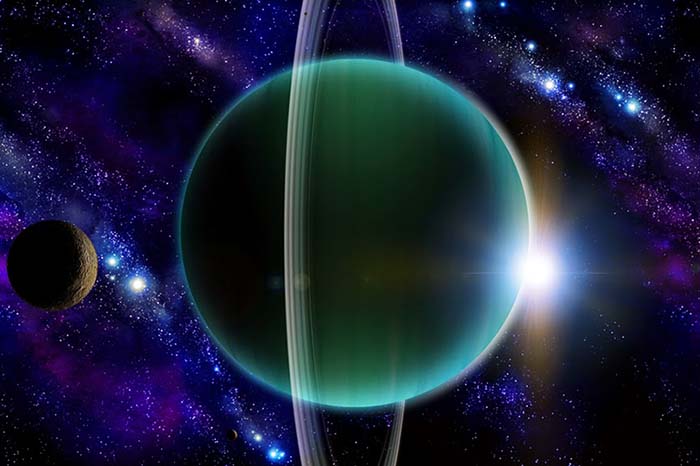

Uranus is the seventh planet from the Sun and the third largest (by diameter). Uranus is larger in diameter but smaller in mass than Neptune.
Uranus was the first planet to be discovered that was not known in ancient times; although it had been observed on many previous occasions, it was always mistakenly identified as a star. The earliest recorded sighting was in 1690 when John Flamsteed catalogued it as 34 Tauri. Flamsteed observed Uranus twice again. Sir William Herschel formally discovered the planet on March 13, 1781, but reported it on April 26, 1781, as a "comet."
Herschel originally named it Georgium Sidus (George's Star) in honor of King George III of Great Britain. When it was pointed out that sidus means star and not planet, he rebaptised it the Georgian Planet. This name was not acceptable outside of Britain.
Lalande proposed in 1784 to name it Herschel, at the same time that he created the planet's symbol ("a globe surmounted by your initial"); his proposal was readily adopted by French astronomers. Prosperin, of Uppsala, proposed the names Astraea, Cybele, and Neptune (now borne by two asteroids and a planet).
Lexell, of St. Petersburg, compromised with George III's Neptune and Great-Britain's Neptune. Bernoulli, from Berlin, suggested Hypercronius and Transaturnis. Lichtenberg, from Gttingen, chimed in with Austraa, a goddess mentioned by Ovid (but who is traditionally associated with Virgo).
The name Minerva was also proposed.
Finally, Bode, as editor of the Berliner Astronomisches Jahrbuch, opted for Uranus, after Latinized version of the Greek god of the sky, Ouranos; Maximilian Hell followed suit by using it in the first ephemeris, published in Vienna. Examination of earliest issues of Monthly Notices of the Royal Astronomical Society from 1827 shows that the name Uranus was already the most common name used even by British astronomers by then, and probably earlier.
The name Georgium Sidus or "the Georgian" were still used infrequently (by the British alone) thereafter. The final holdout was HM Nautical Almanac Office, which did not switch to Uranus until 1850.
In the Chinese, Japanese, Korean, and Vietnamese languages, the planet's name is literally translated as the sky king star.
Uranus is the only planet whose name is derived from a figure from Greek mythology rather than Roman mythology like the other planets, from the Latinized version of the Greek god of the sky, Ouranos. Like the other giant planets, Uranus has a ring system, a magnetosphere, and numerous moons. The Uranian system has a unique configuration among those of the planets because its axis of rotation is tilted sideways, nearly into the plane of its revolution about the Sun. Its north and south poles therefore lie where most other planets have their equators.
In 1986, images from Voyager 2 showed Uranus as a virtually featureless planet in visible light without the cloud bands or storms associated with the other giants. Terrestrial observers have seen signs of seasonal change and increased weather activity in recent years as Uranus approached its equinox. The wind speeds on Uranus can reach 250 meters per second (900 km/h, 560 mph)

Uranus is composed primarily of rock and various ices, with about 85% hydrogen, 15% helium and traces of methane (in contrast to Jupiter and Saturn which are almost entirely hydrogen). Uranus (like Neptune) is very much similar to the cores of Jupiter and Saturn without the massive liquid metallic hydrogen envelope. It appears that Uranus does not have a rocky core like Jupiter and Saturn but rather that its material is more or less uniformly distributed. Uranus' cyan color is due to the absorption of red light by atmospheric methane.
One of the most distinctive features of Uranus is its axial tilt of ninety-eight degrees. Consequently, for part of its orbit one pole faces the Sun continually while the other pole faces away. At the other side of Uranus' orbit the orientation of the poles towards the Sun is reversed. Between these two extremes of its orbit the Sun rises and sets around the equator normally.
At the time of Voyager 2's passage in 1986, Uranus' south pole was pointed almost directly at the Sun. Note that the labelling of this pole as "south" is actually in some dispute. Uranus can either be described as having an axial tilt of slightly more than 90”, or it can be described as having an axial tilt of slightly less than 90” and rotating in a retrograde direction; these two descriptions are exactly equivalent as physical descriptions of the planet but result in different definitions of which pole is the North Pole and which is the South Pole.
One result of this odd orientation is that the polar regions of Uranus receive a greater energy input from the Sun than its equatorial regions. Uranus is nevertheless hotter at its equator than at its poles, although the underlying mechanism which causes this is unknown. The reason for Uranus' extreme axial tilt is also not known. It is speculated that perhaps during the formation of the planet it collided with an enormous protoplanet, resulting in the skewed orientation.
It appears that Uranus' extreme axial tilt also results in extreme seasonal variations in its weather. During the Voyager 2 flyby, Uranus' banded cloud patterns were extremely bland and faint. Recent Hubble Space Telescope observations, however, show a more strongly banded appearance now that the Sun is approaching Uranus' equator. By 2007 the Sun will be directly over Uranus's equator.
Uranus' magnetic field is odd for it is not centered on the center of the planet and is tilted almost 60” from the axis of rotation. It is probably generated by motion at relatively shallow depths within Uranus. Neptune has a similarly displaced magnetic field, which suggests the magnetic field is not necessarily a consequence of Uranus' axial tilt. The magnetotail is twisted by the planet's rotation into a long corkscrew shape behind the planet. The magnetic field's source is unknown; the electrically conductive, super-pressurized ocean of water and ammonia once thought to lie between the core and the atmosphere now appears to be nonexistent.
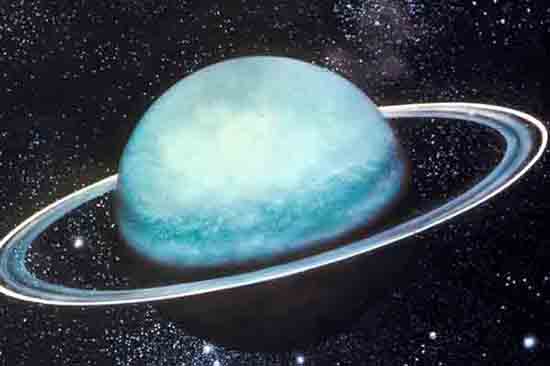
Uranus has a faint planetary ring system, composed of dark particulate matter up to ten meters in diameter. This ring system was discovered in March 1977 by James L. Elliot, Edward W. Dunham, and Douglas J. Mink using the Kuiper Airborne Observatory. The discovery was serendipitous; they planned to use the occultation of a star by Uranus to study the planet's atmosphere.
However, when their observations were analyzed, they found that the star had disappeared briefly from view five times both before and after it disappeared behind the planet. They concluded that there must be a ring system around the planet; it was directly detected when Voyager 2 passed Uranus in 1986. As of 2005, 13 rings had been identified.
In December 2005, the Hubble Space Telescope photographed a pair of previously unknown rings. The largest is twice the diameter of the planet's previously known rings. The new rings are so far from the planet that they are being called Uranus's "second ring system." Hubble also spotted two small satellites. One shares its orbit with one of the newly discovered rings. The new data reveals that the orbits of Uranus's family of inner moons have changed significantly in the last decade.
In April 2006, information about two more rings was published, one of them appearing blue and the other red. The rest of the planet's rings appear grey. The blue ring is thought to get its color from being swept by a moon, which may draw away all large debris, leaving only fine dust which refracts light in much the same way the Earth's atmosphere does.
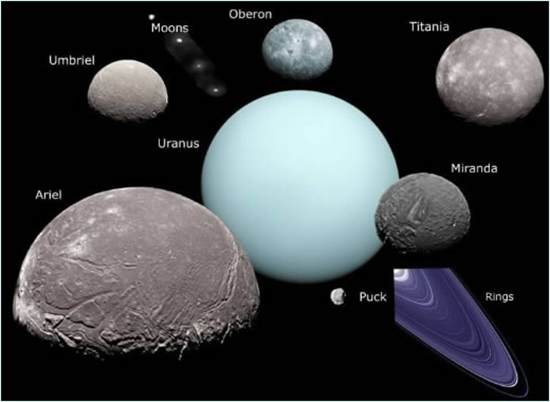
Uranus has 27 known moons. The names for these moons are chosen from characters from the works of Shakespeare and Alexander Pope. The five main satellites are Miranda, Ariel, Umbriel, Titania, and Oberon. The Uranian satellite system is the least massive among those of the giant planets; indeed, the combined mass of the five major satellites would be less than half that of Triton alone.
The largest of the Uranian satellites, Titania, has a radius of only 788.9 km, or less than half that of the Earth's moon, but slightly more than Rhea, the second largest satellite of Saturn, making Titania the eighth largest moon in the Solar System. The Uranian satellites have relatively low albedos; ranging from 0.20 for Umbriel to 0.35 for Ariel (in green light). They are iceŠrock conglomerates composed of roughly 50% ice and 50% rock. The ice may include ammonia and carbon dioxide.
Among the Uranian satellites, Ariel appears to have the youngest surface with the fewest impact craters and Umbriel's the oldest.Miranda possesses fault canyons 20 kilometers deep, terraced layers, and a chaotic variation in surface ages and features.Miranda's past geologic activity is believed to have been driven by tidal heating at a time when its orbit was more eccentric than currently, probably as a result of a former 3:1 orbital resonance with Umbriel. Extensional processes associated with upwelling diapirs are the likely origin of Miranda's 'racetrack'-like coronae. Similarly, Ariel is believed to have once been held in a 4:1 resonance with Titania.
Uranus possesses at least one horseshoe orbiter occupying the SunŠUranus L3 Lagrangian point Š a gravitationally unstable region at 180¼ in its orbit, 83982 Crantor. Crantor moves inside Uranus's co-orbital region on a complex, temporary horseshoe orbit. 2010 EU65 is also a promising Uranus horseshoe librator candidate.
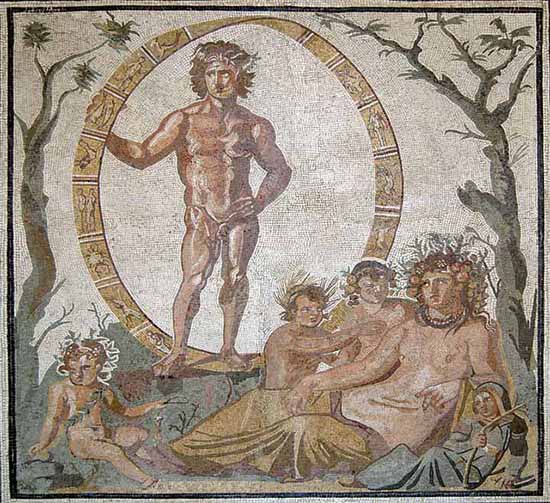
In Greek mythology, Uranus is the personification of the heavens and the night sky. The planet Uranus is very unusual among the planets in that it rotates on its side, so that it presents each of its poles to the Sun in turn during its orbit; causing both hemispheres to alternate between being bathed in light and lying in total darkness over the course of the orbit. Uranus is the sky god and first ruler. He is the son of Gaea, who created him without help. He then became the husband of Gaea and together they had many offspring, including the twelve major Titans.
Cronus was the ruling Titan who came to power by castrating his Father Uranus. His wife was Rhea. There offspring were the first of the Olympians. To insure his safety Cronus ate each of the children as they were born. This worked until Rhea, unhappy at the loss of her children, tricked Cronus into swallowing a rock, instead of Zeus. When he grew up Zeus would revolt against Cronus and the other Titans, defeat them, and banish them to Tartarus in the underworld. Cronus managed to escape to Italy, where he ruled as Saturn. The period of his rule was said to be a golden age on Earth, honored by the Saturnalia feast.
Uranus (meaning "sky" or "heaven") was the primal Greek god personifying the sky. His equivalent in Roman mythology was Caelus. In Ancient Greek literature, Uranus or Father Sky was the son and husband of Gaia, Mother Earth. According to Hesiod's Theogony, Uranus was conceived by Gaia alone, but other sources cite Aether as his father.[3] Uranus and Gaia were the parents of the first generation of Titans, and the ancestors of most of the Greek gods, but no cult addressed directly to Uranus survived into Classical times,[4] and Uranus does not appear among the usual themes of Greek painted pottery. Elemental Earth, Sky and Styx might be joined, however, in a solemn invocation in Homeric epic. Read more ...
Uranus rules Aquarius sudden change, breakthroughs and revolution.
For some modern Western astrologers, the planet Uranus is the ruling planet of Aquarius and is exalted in Scorpio. Uranus takes 84 years to orbit the Sun, spending about 7 years in each sign of the zodiac. Astrologically modern interpretations associate Uranus with the principles of genius, individuality, new and unconventional ideas, discoveries, electricity, inventions, and the beginnings of the industrial revolution. Uranus, among all planets, most governs genius.
Uranus governs societies, clubs, and any group dedicated to humanitarian or progressive ideals. Uranus, the planet of sudden and unexpected changes, rules freedom and originality. In society, it rules radical ideas and people, as well as revolutionary events that upset established structures.
In art and literature, the discovery of Uranus coincided with the Romantic movement, which emphasized individuality and freedom of expression. In medicine, Uranus is believed to be particularly associated with the sympathetic nervous system, mental disorders, breakdowns and hysteria, spasms, and cramps. Uranus is considered by modern astrologers to be ruler of the eleventh house.
For The First Time, Scientists Have Detected a Cyclone on The North Pole of Uranus Science Alert - May 26, 2023
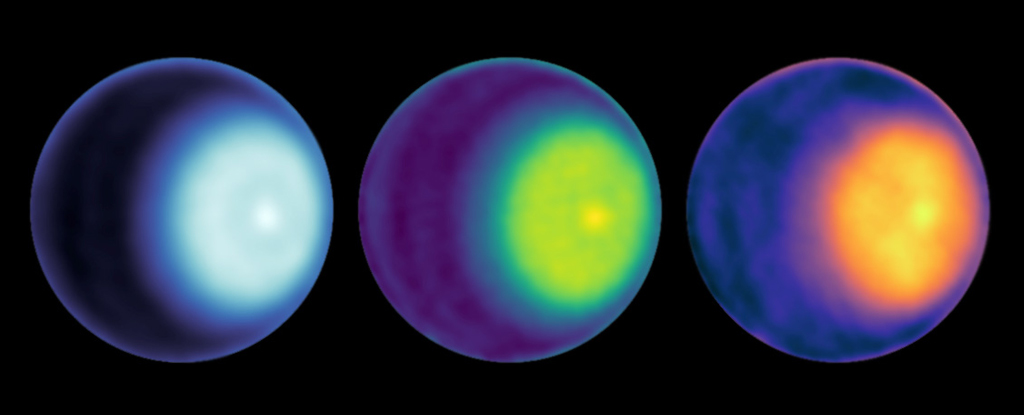
Uranus takes 84 years to orbit the Sun, and so that last time that planet's north polar region was pointed at Earth, radio telescope technology was in its infancy. But now, scientists have been using radio telescopes like the Very Large Array (VLA) the past few years as Uranus has slowly revealed more and more of its north pole.
New Picture Of Uranus's Rings Is Nothing Short Of Magnificent IFL Science - April 6, 2023
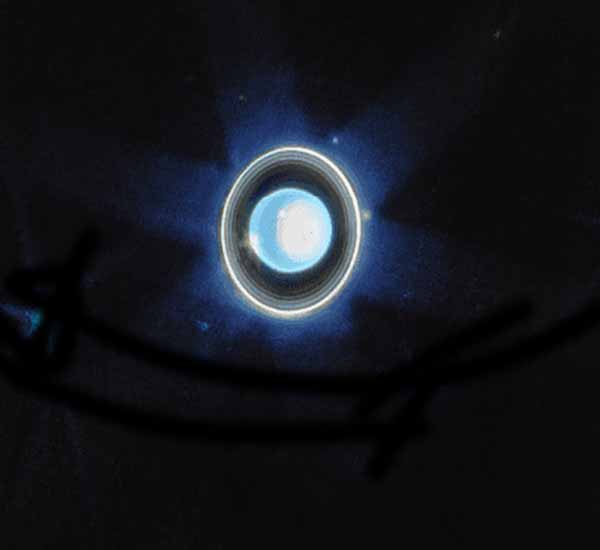
Uranus is surrounded by a system of faint rings, but they are not easily spotted. Before today, only the Voyager 2 spacecraft during its flyby of the planet in 1986 and the Keck Observatory have been able to see them. Now, enter JWST, showing that the latest space telescope is more than up to the task of seeing these faint structures - and much more.
Uranus is belching X-rays and is weirder than we ever thought Space.com - March 30, 2021
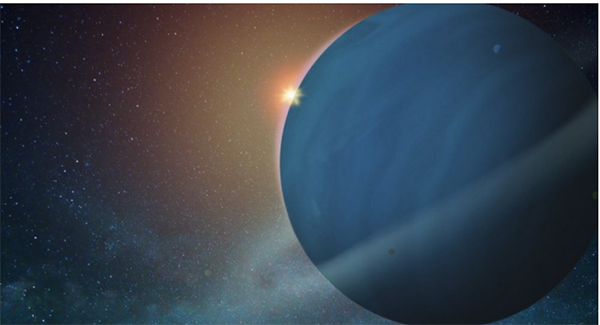
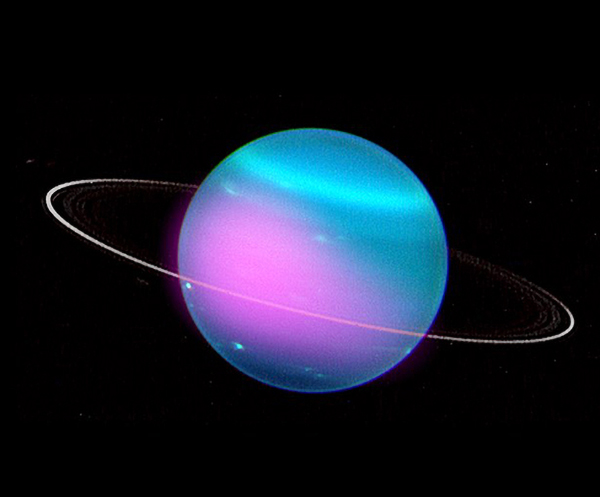
The first observation revealed a clear detection of X-rays, and the second revealed a possible flare of X-rays on the ice giant, a planet mainly composed of elements heavier than hydrogen and helium. In the new study, researchers used Chandra observations taken in Uranus in 2002 and then again in 2017. They saw a clear detection of X-rays from the first observation, just analyzed recently, and a possible flare of X-rays in those obtained fifteen years later. The main graphic shows a Chandra X-ray image of Uranus from 2002 (in pink) superimposed on an optical image from the Keck-I Telescope obtained in a separate study in 2004. The latter shows the planet at approximately the same orientation as it was during the 2002 Chandra observations.
Clues revealed about hidden interior of Uranus PhysOrg - November 14, 2014
Long believed to be one of the blandest regions of any of the giant gas planets, the southern hemisphere of Uranus indicates a flurry of previously unknown atmospheric phenomena, hinting at an unusual feature in the interior of the planet. By re-analyzing images that NASA's Voyager-2 spacecraft took 28 years ago, astronomer Erich Karkoschka has teased out hidden features in Uranus' atmosphere that reveal an unexpected, strange rotation pattern and point to the possible existence of an unusual feature inside the planet's interior. The findings shed light on the interior structures of giant gas planets, not only of Uranus, a planet for which observational data are sparse, but also those of the many extrasolar planets that are being discovered.
Planet Uranus rings the changes BBC - August 23, 2007
Astronomers have captured remarkable new images of the rings of Uranus. The rings are currently edge-on to Earth, in an event that only happens every 42 years.
Seventh planet has a blue ring BBC - April 6, 2006
Astronomers have discovered that the planet Uranus has a blue ring - only the second found in the Solar System. Like the blue ring of Saturn, it probably owes its existence to an accompanying small moon. Scientists suspect subtle forces acting on dust in the rings allow smaller particles to persist while larger ones are recaptured by the moon. Smaller particles reflect blue light, giving the ring its distinctive color, the US team reports in Science. All other rings - those around Jupiter, Saturn, Uranus and Neptune - are made up of both large and small particles, making the rings reddish in appearance.
Planet Uranus caught on VLT BBC - December 31, 2002
The Very Large Telescope (VLT) has caught a remarkable image of the planet Uranus circled by some of its moons. The rings of the planet - which is 3,000 million kilometres away from Earth - are clearly displayed in the image. The rings are almost undetectable from Earth in visible light. The VLT is located at the European Southern Observatory's Paranal Observatory in Chile. The image was obtained in the near-infrared, and includes seven of the planet's moons.